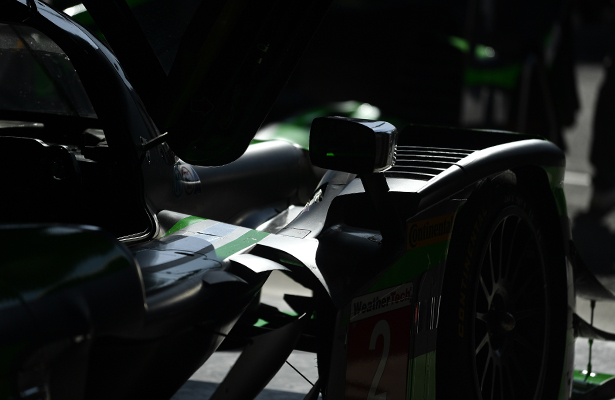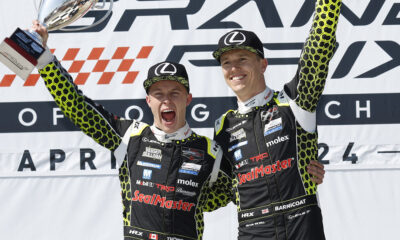
Photo: Rick Dole/IMSA
Scott Atherton says there’s “genuine interest” from IMSA and the ACO to achieve a common set of global prototype regulations for 2020, with preliminary discussions between both organizations already underway.
The IMSA President, meanwhile, revealed they’d be open to the possible integration of cost-effective hybrid powertrains in the next-generation platform, which he hopes would be an “evolution” from its current DPi formula.
The development comes in the wake of a planned overhaul to the initially announced LMP1 regulations for 2020, which called for fast-charging hybrid plug-ins and stretches of all-electric driving, that has since been abandoned in the wake of Porsche’s exit from the FIA World Endurance Championship’s top class at the end of this season.
It’s resulted in a complete re-think of LMP1, that could see a shared platform with the next generation of IMSA’s DPi regulations, which is due out in 2021.
Atherton confirmed that option was initially discussed late last month, although admitted there’s still “a lot more questions than answers” at this point.
“It’s good that we’re together and we’re discussing it as an opportunity,” Atherton told Sportscar365.
“We see it, as an organization, as only being a positive if we could bring the rulebooks together and have the top prototype category in America, racing in the WeatherTech Championship, [to] be aligned, consistent with what races at Le Mans and in the WEC.
“There’s a genuine interest on both sides of the equation, the ACO and IMSA, to do all we can to fulfill that.”
A push for a common set of future LMP1/DPi regulations has been made by a number of manufacturers, including McLaren and Ford, which have both indicated interest in mounting factory prototype efforts should it be able to fight for overall wins at Daytona, Sebring and Le Mans with the same car.
While Atherton said he hasn’t been in any specific discussions with manufacturers, he admitted it’s a desirable option that would likely expand global prototype involvement.
“If you’re able to look around the next corner to the 2020/2021 timeframe and have the alignment occur, I think it would only serve to accelerate that and attract others that are not currently involved,” he said. “That’s the ultimate goal.”
IMSA Open to Hybrid Powertrains
While the FIA and ACO’s desire to continue with hybrid technology appeared to initially be a potential roadblock for a common platform, Atherton revealed that IMSA is open to that possibility, as long as it can be done in a cost-effective manner.
“What’s called for in the current LMP1 rulebook has proven to be unsustainable, so you wouldn’t want to engage in a similar set of circumstances, even if you had someone willing to say we’ll compete at that level,” he said.
“It would [have to] be based upon practical availability, affordability and sustainability.”
He admitted hybrids could be an option for the next set of regulations in the prototype class.
“From IMSA’s perspective, it’s not a question of if but when hybridization becomes part of everything we’re doing,” Atherton said.
“If you look at every major automobile manufacturer, they’re either talking about an all-hybrid lineup of vehicles or an all-electric lineup of vehicles in the not-too-distant future, 2025, 2030.
“I think all forms of motorsport need to be cognizant of that so you don’t box yourself in with a set of rules that out of sync with the practical application of the automobile from the manufacturers and in the eyes of the consumer.”
Atherton said his initial impressions of the ACO’s Equivalence of Technology, which will balance turbocharged and normally aspirated engines, along with hybrid technology, into a single interim LMP1 class for 2018/19, has been positive.
“On the surface, that sounds attractive,” he said. “It sounds like a good fit for what is today a DPi example.
“Right now we do not have a formula that calls for hybrid technology in DPi. If you’re talking about the next generation, and seeing what’s happening around us, it seems like the logical next step.”
Evolution of DPi Regulations Optimal
With involvement from Cadillac, Mazda, Nissan and soon-to-be Acura in DPi, Atherton said he would envision the next set of prototype regulations to be an evolution, rather than a complete new approach.
“I think [DPi] has proven to be an attractive opportunity for manufacturers,” he said.
“We think the cars are delivering what the fans want. They have a visual uniqueness to them. Their powertrains are generating excellent competitive results, albeit [in different ways].
“There’s a level of affordability as a result of using four constructors, bodywork kits and allowing OEMs to bring powertrains to the mix that seems to work.
“Looking forward, from our perspective, an evolution of what is today’s DPi would be optimal.”
Atherton said he would expect a transition period of 1-2 years, in allowing current DPi machinery to continue to compete in the class alongside new-generation cars, which could enter competition globally in 2020.
The current DPi regulations are guaranteed through the end of the 2020 WeatherTech Championship season.
“There’s questions in our mind right now about the timing of how the ‘Super Season’ and the impact that has on existing homologations,” Atherton said.
“Our commitment to our DPi constructors is unwavering, in that this is a four-year homologation, so that takes us through the 2020 season.
“That could be that blended scenario of having existing, still eligible [DPi cars], but also allowing the next-generation specification to cycle in. But all of this is speculative.”
With the FIA and ACO having declared plans to finalize the regulations by the end of this year, Atherton said IMSA would be ready to step up to help determine the unified platform, should talks move forward in the coming weeks.
“The vision there, from our perspective, would be a joint process,” he said. “If the goal is to have common regulations, then both parties would need to be actively involved in crafting them.
“Our technical team would absolutely make it a priority.”























